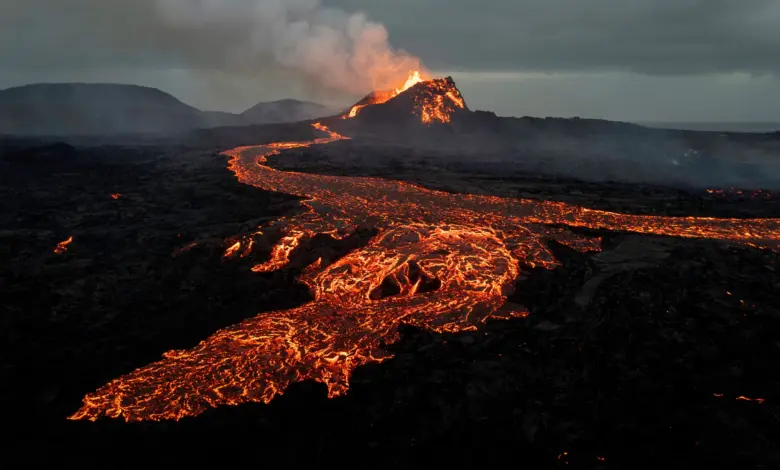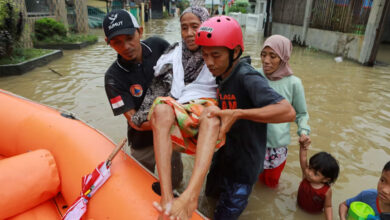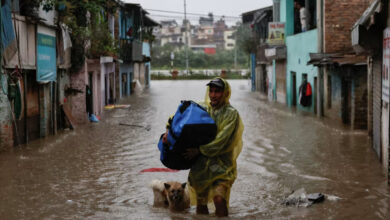
Mount Tambora changed the world. In 1815, the Indonesian volcano exploded in the most powerful eruption in recorded history, sending an enormous plume of tiny sun-reflecting particles high into the atmosphere, cooling the planet and ushering in disaster.
What followed was called the “year without a summer:” global temperatures plunged, crops failed, people starved, a cholera pandemic spread and tens of thousands died. Some even credit the volcano with inspiring Mary Shelley to write Frankenstein, while sheltering from unusually cold weather in Switzerland in 1816.
Many volcanoes have erupted since, but Tambora remains the planet’s most recent massive eruption. More than 200 years later, scientists warn the world may be due another.
The question is not if, but when, said Markus Stoffel, a climate professor at the University of Geneva. Geological evidence suggests a 1-in-6 chance of a massive eruption this century, he told CNN.
This time, however, it would happen in a much-changed world, one which is not only more populated but which has also been warmed by the climate crisis.
The next massive eruption will “cause climate chaos,” Stoffel said. “Humanity does not have any plan.”


Volcanoes have long shaped our world; they help create continents, have built the atmosphere and can change the climate.
As they erupt, they eject a cocktail of lava, ash and gases, including planet-heating carbon dioxide, although in quantities dwarfed by those humans produce burning fossil fuels.
When it comes to climate impact, scientists are more interested in another gas: sulfur dioxide.
A massive volcanic eruption can propel sulfur dioxide through the troposphere — the part of the atmosphere where weather happens — and into the stratosphere, the layer about 7 miles above the Earth’s surface where planes fly.
Here, it forms tiny aerosol particles which scatter sunlight, reflecting it back into space and cooling the planet below. These particles “will blow around the world and last for a couple years,” said Alan Robock, a climate professor at Rutgers University who has spent decades studying volcanoes.
For modern volcanoes, satellite data shows how much sulfur dioxide is released. When Mount Pinatubo in the Philippines erupted in 1991, it propelled roughly 15 million tons into the stratosphere. This wasn’t a massive eruption like Tambora, but it still cooled the world by around 0.5 degrees Celsius for several years.
For older volcanoes, however, “we have very poor data,” Stoffel said. Scientists try to reconstruct these past eruptions using information from ice cores and tree rings, which are like time capsules, storing secrets of the past atmosphere.
From this they know massive eruptions over the last several thousand years temporarily cooled the planet by about 1 to 1.5 degrees Celsius.
Tambora, for example, lowered average global temperatures by at least 1 degree Celsius. There is evidence the huge Samalas eruption in Indonesia in 1257 may have helped trigger the “Little Ice Age,” a cold period that lasted hundreds of years.
There are also indications that massive eruptions may affect rainfall, drying monsoon systems including those in Africa and Asia. “The monsoon in the summer happens because the land warms faster than the ocean,” Robock said. A huge volcanic eruption can disrupt the temperature difference between the two.
‘A more unstable world’
Understanding the impacts of past massive eruptions is vital, but the next will happen in a world that is much warmer than before humans began burning large amounts of oil, coal and gas.
“It’s a more unstable world now,” said Michael Rampino, a professor at NYU, who investigates links between volcanic eruptions and climate change. “The effects might be even worse than we saw back in 1815.”
In what may seem a counterintuitive twist, a warmer world may mean massive volcanic eruptions have an even bigger cooling impact.
That’s because how aerosol particles form and how they are transported is “all dependent on climate,” said Thomas Aubry, a physical volcanology scientist at the University of Exeter.
As the world warms, the speed at which air circulates in the atmosphere is increasing, meaning aerosol particles are dispersed faster and have less time to grow, Aubry said. Smaller aerosols can scatter sunlight more efficiently than large ones, meaning the cooling impact will be greater.
Oceans may also play a role. As the surface of the ocean heats up, a layer of lighter, warmer water sits on top and acts as a barrier to mixing between shallow and deeper layers. This may mean eruptions disproportionately cool the ocean’s top layer and the atmosphere above it, Stoffel said.
Climate change can also affect volcanic systems themselves. Melting ice can lead to increased eruptions, as its disappearance decreases pressure, which can allow magma to rise faster. Scientists have also found more extreme rainfall — driven by climate change — can seep deep into the ground where it can react with magma to trigger an eruption, Aubry said.
Impossible to predict
As the world grapples with global warming, a period of cooling might sound positive. Scientists say the opposite is true.

First, there’s the immediate impact. An estimated 800 million people live within around 60 miles of an active volcano; a massive eruption could erase an entire city. Campi Flegrei, for example, has shown signs of stirring and sits just west of the Italian city of Naples, home to around 1 million people.
Longer-term, the impacts could be cataclysmic. A 1 degree Celsius drop in temperature might sound small, but it’s an average. “If we look at certain regions, the impact will be much greater,” said May Chim, an Earth scientist at the University of Cambridge.
Okmok in Alaska, which erupted in 43 BC — the year after Julius Caesar was assassinated — could have cooled parts of southern Europe and northern Africa by up to 7 degrees Celsius, or 13 degrees Fahrenheit.
Colder weather, less sunlight and shifting rainfall could affect several breadbaskets at once, including the US, China and Russia, hitting global food security and potentially leading to political tensions, even war, according to a recent analysis by the insurers Lloyd’s.
The human and economic toll would be vast. In an extreme scenario, similar to Tambora, economic losses could reach more than $3.6 trillion in the first year alone, Lloyd’s calculated.
What’s more, the cooling would offer no relief from climate change; within a few years, the planet would return to how it was before.
The next eruption could happen anywhere. There are areas scientists are watching, including Indonesia, one of the planet’s most volcanically active regions, and Yellowstone, in Western US, which hasn’t experienced a huge eruption for hundreds of thousands of years.
“But which one next and when — that’s still impossible to predict,” Stoffel said.
Massive volcanic eruptions cannot be prevented, but there are ways to prepare, Stoffel added. He called for experts to assess worst-case scenarios, run stress tests and come up with plans: everything from evacuations to aid efforts and securing food supplies.
While some might say the probability of a massive eruption is still small, “it’s really not nothing,” Stoffel said, and currently the world is unprepared for impacts it would unleash. “We’re just at the beginning of getting an idea of what could happen.”






